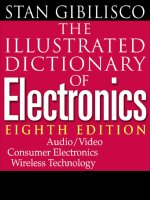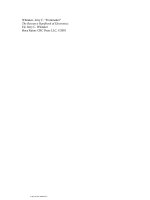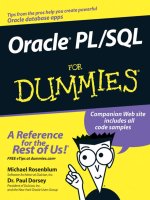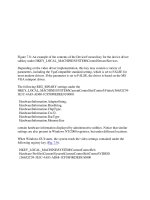Tài liệu The Resource Hanbook of Electronics P1 doc
Bạn đang xem bản rút gọn của tài liệu. Xem và tải ngay bản đầy đủ của tài liệu tại đây (737.08 KB, 30 trang )
Whitaker, Jerry C. “Frontmatter”
The Resource Handbook of Electronics.
Ed. Jerry C. Whitaker
Boca Raton: CRC Press LLC, ©2001
© 2001 by CRC PRESS LLC
ELECTRONICS
The
Resource
Handbook
of
© 2001 by CRC PRESS LLC
ELECTRONICS HANDBOOK SERIES
Series Editor:
Jerry C. Whitaker
Technical Press
Morgan Hill, California
PUBLISHED TITLES
AC POWER SYSTEMS HANDBOOK, SECOND EDITION
Jerry C. Whitaker
THE COMMUNICATIONS FACILITY DESIGN HANDBOOK
Jerry C. Whitaker
THE ELECTRONIC PACKAGING HANDBOOK
Glenn R. Blackwell
POWER VACUUM TUBES HANDBOOK, SECOND EDITION
Jerry C. Whitaker
MICROELECTRONICS
Jerry C. Whitaker
SEMICONDUCTOR DEVICES AND CIRCUITS
Jerry C. Whitaker
SIGNAL MEASUREMENT, ANALYSIS, AND TESTING
Jerry C. Whitaker
THERMAL DESIGN OF ELECTRONIC EQUIPMENT
Ralph Remsburg
THE RESOURCE HANDBOOK OF ELECTRONICS
Jerry C. Whitaker
FORTHCOMING TITLES
ELECTRONIC SYSTEMS MAINTENANCE HANDBOOK
Jerry C. Whitaker
© 2001 by CRC PRESS LLC
ELECTRONICS
Jerry C. Whitaker
Technical Press
Morgan Hill, California
The
Resource
Handbook
of
Boca Raton London New York Washington, D.C.
CRC Press
© 2001 by CRC PRESS LLC
This book contains information obtained from authentic and highly regarded sources. Reprinted material
is quoted with permission, and sources are indicated. A wide variety of references are listed. Reasonable
efforts have been made to publish reliable data and information, but the author and the publisher cannot
assume responsibility for the validity of all materials or for the consequences of their use.
Neither this book nor any part may be reproduced or transmitted in any form or by any means, electronic
or mechanical, including photocopying, microfilming, and recording, or by any information storage or
retrieval system, without prior permission in writing from the publisher.
The consent of CRC Press LLC does not extend to copying for general distribution, for promotion, for
creating new works, or for resale. Specific permission must be obtained in writing from CRC Press LLC
for such copying.
Direct all inquiries to CRC Press LLC, 2000 N.W. Corporate Blvd., Boca Raton, Florida 33431.
Trademark Notice:
Product or corporate names may be trademarks or registered trademarks, and are
used only for identification and explanation, without intent to infringe.
© 2001 by CRC Press LLC
No claim to original U.S. Government works
International Standard Book Number 0-8493-8353-6
Library of Congress Card Number 00-057935
Printed in the United States of America 1 2 3 4 5 6 7 8 9 0
Printed on acid-free paper
Library of Congress Cataloging-in-Publication Data
Whitaker, Jerry C.
The resource handbook of electronics / Jerry C. Whitaker.
p. cm.--(The Electronics handbook series)
Includes bibliographical references and index.
ISBN 0-8493-8353-6 (alk. paper)
1. Electonics--Handbooks, manuals, etc. I. Title. II. Series.
TK7825 .W48 2000
621.381--dc21 00-057935
© 2001 by CRC PRESS LLC
Preface
The hallmark of the CRC Press “Electronics Engineering Series” of books is their
depth of coverage on targeted subjects. Even the more general-interest publication of
the series—The Electronics Handbook—covers the entire realm of electronics in ex
-
ceptional detail.
This book is a departure from those that have gone before it. The Resource Hand
-
book of Electronics is intended to provide quick access to basic information, mostly
through figures and tables. For each of the 20-plus chapters, a broad-brush overview is
given, followed in most cases by extensive tabular data. The Resource Handbook of
Electronics is intended for readers who need specific data at their fingertips, accessible
in a convenient format.
This book is intended for engineers, technicians, operators, and technical managers
involved in the specification, design, installation, operation, maintenance, and man
-
agement of electronics facilities. The book is designed to be a hands-on pocket guide
that holds solutions to specific problems. In this regard, it is a companion publication to
The Electronics Handbook and the other books in the series. For readers who need ex-
tensive background on a given subject, The Electronics Handbook and its related works
provide the necessary level of detail. For readers who need a broad overview of the sub-
ject and essential data relating to it, The Resource Handbook of Electronics is the ideal
publication.
This book is organized in a logical sequence that begins with fundamental electrical
properties and builds to higher levels of sophistication from one chapter to the next.
Chapters are devoted to all of the most common components and devices, in addition to
higher-level applications of those components.
Among the extensive data contained in The Resource Handbook of Electronics are
•
Frequency assignments—A complete and up-to-date listing of frequencies used
by various services in the U.S. and elsewhere
•
Glossary of terms—An extensive dictionary of electronic terms, including ab
-
breviations and acronyms
•
Conversion factors—Detailed tables covering all types of conversion require
-
ments in the field of electronics
The Resource Handbook of Electronics is the most detailed publication of its kind. I
trust you will find it useful on the job, day in and day out.
Jerry C. Whitaker
Morgan Hill, California
© 2001 by CRC PRESS LLC
For updated information on this and other engineering books, visit the author’s
Internet site
www.technicalpress.com
© 2001 by CRC PRESS LLC
About the Author
Jerry Whitaker is a technical writer based in Morgan Hill, California, where he op
-
erates the consulting firm Technical Press. Mr. Whitaker has been involved in various
aspects of the communications industry for more than 25 years. He is a Fellow of the
Society of Broadcast Engineers and an SBE-certified Professional Broadcast Engi
-
neer. He is also a member and Fellow of the Society of Motion Picture and Television
Engineers, and a member of the Institute of Electrical and Electronics Engineers. Mr.
Whitaker has written and lectured extensively on the topic of electronic systems in
-
stallation and maintenance.
Mr. Whitaker is the former editorial director and associate publisher of Broadcast
Engineering and Video Systems magazines. He is also a former radio station chief engi
-
neer and TV news producer.
Mr. Whitaker is the author of a number of books, including:
•
The Communications Facility Design Handbook, CRC Press, 2000.
•
Power Vacuum Tubes Handbook, 2nd edition, CRC Press, 1999.
•
AC Power Systems, 2nd edition, CRC Press, 1998.
•
DTV: The Revolution in Electronic Imaging, 2nd edition, McGraw-Hill, 1999.
•
Editor-in-Chief, NAB Engineering Handbook, 9th edition, National Association
of Broadcasters, 1999.
•
Editor-in-Chief, The Electronics Handbook, CRC Press, 1996.
•
Coauthor, Communications Receivers: Principles and Design, 2nd edition,
McGraw-Hill, 1996.
•
Electronic Displays: Technology, Design, and Applications, McGraw-Hill,
1994.
•
Coeditor, Standard Handbook of Video and Television Engineering, 3rd edition,
McGraw-Hill, 2000.
•
Coeditor, Information Age Dictionary, Intertec/Bellcore, 1992.
•
Maintaining Electronic Systems, CRC Press, 1991.
•
Radio Frequency Transmission Systems: Design and Operation, McGraw-Hill,
1990.
Mr. Whitaker has twice received a Jesse H. Neal Award Certificate of Merit from the
Association of Business Publishers for editorial excellence. He also has been recog
-
nized as Educator of the Year by the Society of Broadcast Engineers.
© 2001 by CRC PRESS LLC
Acknowledgment
The author wishes to express appreciation to the following contributors for their assis
-
tance in the preparation of this book.
K. Blair Benson
E. Stanley Busby
Michael W. Dahlgren
Gene DeSantis
Donald C. McCroskey
C. Robert Paulson
© 2001 by CRC PRESS LLC
Table of Contents
Chapter 1: Fundamental Electrical Properties
Introduction
Electrical Fundamentals
Conductors and Insulators
Direct Current (dc)
Alternating Current (ac)
Static Electricity
Noise in Electronic Circuits
References
Bibliography
Tabular Data
Chapter 2: International Standards and Constants
Introduction
The History of Modern Standards
American National Standards Institute (ANSI)
Professional Society Engineering Committees
References
Bibliography
Tabular Data
Chapter 3: Electromagnetic Spectrum
Introduction
Operating Frequency Bands
Low-End Spectrum Frequencies (1 to 1000 Hz)
Low-End Radio Frequencies (1000 to 100 kHz)
Medium-Frequency Radio (20 kHz to 2 MHz)
High-Frequency Radio (2 to 30 MHz)
Very High and Ultrahigh Frequencies (30 MHz to 3 GHz)
Microwaves (3 to 300 GHz)
Infrared, Visible, and Ultraviolet Light
X-Rays
Radio Wave Propagation
Free Space Path Loss
References
Bibliography
Tabular Data
Chapter 4: Frequency Assignment and Allocations
Introduction
The International Telecommunication Union (ITU)
Purposes of the Union
Structure of the Union
© 2001 by CRC PRESS LLC
The Federal Communications Commission (FCC)
National Table of Frequency Allocations
U.S. Government Table of Frequency Allocations
Chapter 5: Light, Vision, and Photometry
Introduction
Sources of Illumination
The Spectrum
Monochrome and Color Vision
Luminosity Curve
Luminance
Luminance Discrimination
Perception of Fine Detail
Sharpness
Response to Intermittent Excitation
References
Bibliography
Tabular Data
Chapter 6: Circuit Fundamentals
Introduction
Circuit Analysis
AC Circuits
Power Relationship in AC Circuits
Complex Numbers
Phasors
Per Unit System
Principles of Resonance
Series Resonant Circuits
Parallel Resonant Circuits
Passive/Active Circuit Components
References
Bibliography
Chapter 7: Resistors and Resistive Materials
Introduction
Resistor Types
Wire-Wound Resistor
Metal Film Resistor
Carbon Film Resistor
Carbon Composition Resistor
Control and Limiting Resistors
Resistor Networks
Adjustable Resistors
Attenuators
References
Bibliography
Tabular Data
© 2001 by CRC PRESS LLC
Chapter 8: Capacitance and Capacitors
Introduction
Practical Capacitors
Polarized/Nonpolarized Capacitors
Operating Losses
Film Capacitors
Foil Capacitors
Electrolytic Capacitors
Ceramic Capacitors
Polarized-Capacitor Construction
Aluminum Electrolytic Capacitors
Tantalum Electrolytic Capacitors
Capacitor Failure Modes
Temperature Cycling
Electrolyte Failures
Capacitor Life Span
References
Bibliography
Chapter 9: Inductors and Magnetic Properties
Introduction
Electromagnetism
Magnetic Shielding
Inductors and Transformers
Losses in Inductors and Transformers
Air-Core Inductors
Ferromagnetic Cores
Shielding
References
Bibliography
Tabular Data
Chapter 10: Filter Devices and Circuits
Introduction
Filter Type
Filter Alignment
Filter Order
Filter Design Implementation
LC Filters
Electrical Resonators
Stripline technology
Electro-Mechanical Filters
Quartz Crystal Resonators
Monolithic Crystal Filters
Ceramic Filters
References
© 2001 by CRC PRESS LLC









